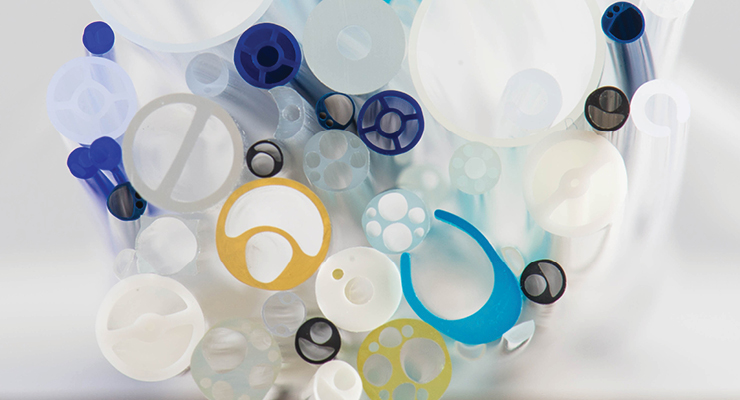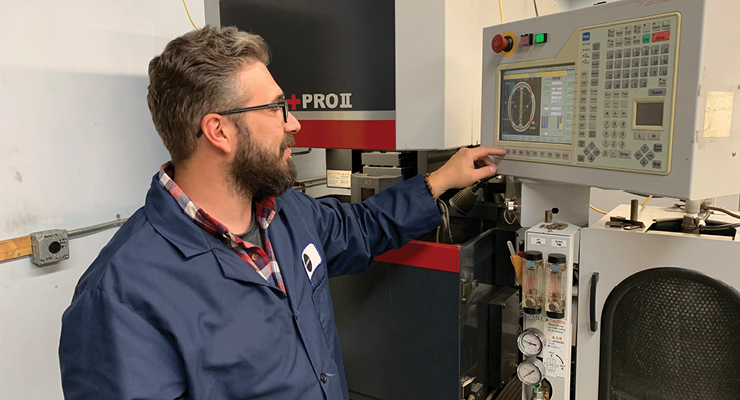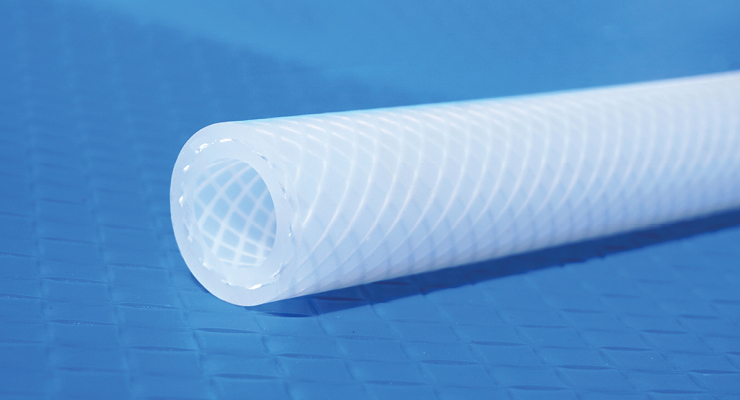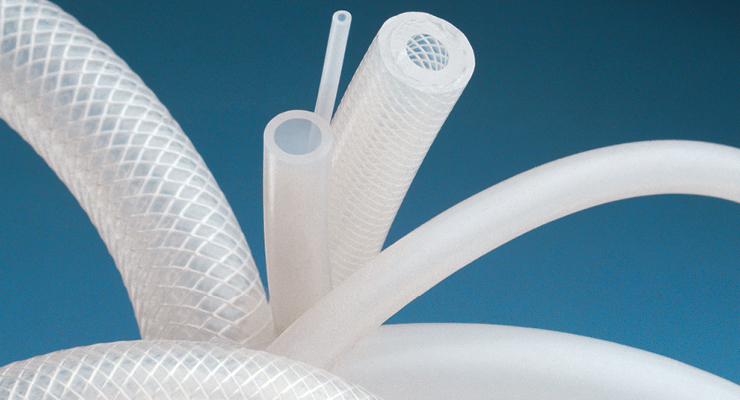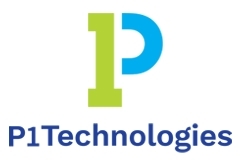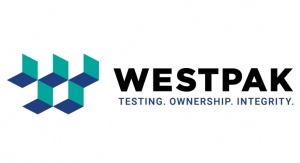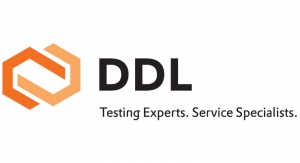Mark Crawford, Contributing Writer04.01.21
Tubing manufacturers were greatly impacted in 2020 by the COVID-19 pandemic. Many OEMs suspended projects, especially requests for tubing that supported elective surgeries. Projects that were advanced quickly were largely for tubing that supported critical-care equipment for COVID-19 patients. With elective surgeries shut down by the end of the second quarter of 2020, hospitals stopped ordering supplies for these surgeries, causing the tubing market to slump by about 35 percent.
“However, during this time, new product development seemed unaffected by the pandemic and actually seemed to increase, which probably kept many of the independent extrusion companies afloat,” said Tim Steele, president of Microspec Corporation, a Peterborough, N.H.-based custom extruder of advanced medical tubing and profiles.
By the end of December 2020, signs of recovery were evident, and so far in 2021, tubing demand/production is up. “Tubing demand is resurging, and customers are revising their forecasts to account for anticipated increases in market demand,” said Gordon Brooks, senior director of product management for Nordson MEDICAL, a Salem, N.H.-based provider of extrusions, heat shrink, film cast, and balloon components and assembly.
Even though demand for advanced medical devices fluctuated wildly in 2020, “with global production and R&D staying strong overall, we expect tremendous growth in 2021,” added Amna Rana, technical sales manager for Cobalt Polymers, a Cloverdale, Calif.-based global heat shrink manufacturer.
Much of this growth will still be related to the ongoing fight against COVID-19, with continued need for medical tubes for drug delivery devices, catheters, nasogastric procedures, nebulizers, and bulk disposable tubing. There is also extremely high demand for tubing used in single-use processes focused on vaccine R&D and production, therapeutic devices such as ventilators, and virus testing.
“We are adding manufacturing capacity in a timely manner to keep up with skyrocketing demand,” said Tony Szoka, national sales manager for NewAge Industries, a Southampton, Pa.-based manufacturer of tubing for a variety of industries, including medical. “However, adding extra production shifts and qualified labor candidates remains challenging.”
Latest Trends
The quest for new catheter-based, minimally invasive treatment options that can replace surgical procedures is a key driver of innovation and growth. “New tubing requests come from both experienced and inexperienced designers seeking to understand the latest material technologies that can provide benefits over existing and emerging material technologies in terms of improved physical properties, lower processing cost, sterilization compatibility, and biocompatibility requirements,” said Robert LaDuca, CEO of Santa Cruz, Calif.-based Duke Empirical, a developer and manufacturer of custom extruded medical tubing and catheter products.
Polytetrafluoroethylene (PTFE) liners continue to be important for a variety of markets, especially interventional vascular. Tubing and hose for single-use systems are in high demand. Other companies seek customized profile/shaped tubing and multi-lumen tubing, which may require specialized extrusion tooling. Development engineers continue to make requests that push the upper and lower limits of polymer technologies. “Many new medical device designs call for a variety of tubing sizes, ranging from 0.002 inches all the way up to 0.4 inches or larger for neurovascular, structural heart, and robotic surgical products,” said Rana.
Silicone continues to be a highly popular material for tubing. However, silicon shortages can still cause especially long lead times for delivery, often resulting in production delays. This supply chain uncertainty is causing some medical device manufacturers (MDMs) to consider silicone alternatives such as thermoplastic elastomers (TPE). TPEs have similar physical and chemical properties compared to silicone.
“TPE can be a lower-cost alternative for companies to consider, with most tubing items in stock,” said Marcia Coulson, president of Eldon James Corporation, a Denver, Colo.-based manufacturer of proprietary and customized tubing and connection solutions for medical devices, life sciences, and pharmaceuticals. “As an alternative to silicone, TPE also meets regulatory standards for bioprocess and biological manufacturing.”
Heat shrinking is gaining in popularity as a method for customizing and differentiating products. The process consists of encasing wires or cables in plastic tubes that shrink when heated to form a secure, protective, exterior layer, protecting the wires or cables from abrasion or other wear and tear. Heat shrink can be applied to catheter shafts, wires, and other substrates with unique or varied profiles. Heat shrink tubing can be color-coded to allow medical staff to quickly determine the function of cables. It is also possible to group multiple cables, wires, and lumens together securely within in a single heat-shrink tube.
“With heat-shrink tubing, customers often don’t realize how flexible their substrate can remain, or how well the heat shrink adheres to their substrates,” said Rana.
A key challenge in interventional medicine is the deployment of unique treatment modalities into delicate, tortuous, or otherwise difficult regions of the body. Traditional braid-reinforced catheters are close to their design limits—as an alternative, spiral-cut hypotube and cable tube-based structures can provide advantages in strength, flexibility, and wall thickness as the core of a system, protected by a polymer jacket created through heat shrink tubing. “Our Pebax and polyolefin heat shrink provide a uniform, ultra-thin jacket [walls as thin as 0.0005 inches] while allowing the underlying substrate to remain flexible” said Rana.
“We have seen multiple requests for fluorinated ethylene propylene [FEP] heat shrink with a very small overall longitudinal change during recovery,” added Jake Wagner, engineering manager for Teleflex Medical OEM, a Gurnee, Ill.-based provider of custom tubing extrusions in both PTFE and melt-processable plastics, at its Jaffrey, N.H. facility. “With our proprietary process settings, we can accommodate these highly specialized requests.”
As their devices become more complex, MDMs turn to their tubing partners to simplify their designs or consolidate parts—resulting in fewer failure points, easier assembly, faster regulatory approval, and ultimately less cost.
“For example, some customers have been looking to replace multiple tubes with one multi-lumen tube or paratube,” said Christian Herrild, director of growth strategies for Teel Plastics, a Baraboo, Wis.-based extruder of custom medical tubing. “We have also seen a desire to take some assembly work out using the same techniques.”
What OEMs Want
Medical device designers keep pushing for a greater variety of physical properties from their tubing—for example, lower friction materials particularly in the softer durometers, higher tensile strengths, higher recoverable elongation, optical clarity, and lower density. Others are looking for specific straightness requirements, surface finish specifications, burr-free perpendicular end cuts, high concentricity, specific circularity, visual requirements, cleanliness specifications, and validation to dimensional, visual, and functional specifications. To combat COVID-19, many MDMs seek specialty products that focus on supporting unique product demands of the vaccine and improving vaccine productivity. Specific characteristics include chemical compatibility, operating temperature, and working and burst pressures.
Almost every MDM wants smaller, thinner-walled tubes with higher tolerances and a balance of flexibility, strength, and lubricity.
“From a processing standpoint, MDM customers are seeking custom draw-down ratios to induce specific properties into the tubing,” said LaDuca. “They also want the smallest interior diameters possible with requests down to 0.004 inches, wall thicknesses of less than 0.001 inches, coextrusion with ultrathin liner layers, and large diameters of 12 mm or greater with thin walls held to tight tolerances of ±0.001 inches.”
Customers are also looking for any process improvements that will speed up production and delivery. This often involves adding services, such as improved inspection, or eliminating secondary steps when possible due to greater production efficiencies. For example, “cleanroom production of tubing is growing in importance to our customers,” said Coulson. “Custom-cut lengths are being requested more often. Customers are looking for ways to improve their process and become more efficient and we are able to help with that through custom-cut lengths.”
In general, OEMs strive to differentiate themselves in the market and meet increased demand to improve patient care, which is driving tubing diameters to ever smaller dimensions. They are asking their tubing suppliers for advice about achieving these challenging design goals and functional requirements. The extensive experience of a tubing manufacturer is invaluable to MDM new product development programs, especially when the MDM does not have a solid background in extruded tubing products. Design engineers often seek to understand how the physical and mechanical properties of a material compare across different resin manufacturers’ polymer product lines and trade names.
“For example, soft elastic materials are chosen for balloon applications where the tubing processor has experience with specific grades of materials to achieve optimal properties such as maximizing recoverable elongation or elongation at break,” said LaDuca.
“Our customers have been looking for material recommendations more than they have historically,” added Herrild. “They are leaning into our material expertise and asking for recommendations, not just on specific grades, but on whole families of materials.”
Regulatory requirements are also driving MDMs to require tubing validations throughout the design cycle. With EU Medical Device Regulation changes taking effect in May, MDMs want more up-front information on material and additive compositions. FDA regulations also continue to demand more documentation. As a result, validation of the extruded tubing process is increasingly more critical to MDMs, making the validation report a highly valuable asset for obtaining FDA approval for a new device. “Twenty years ago, operational qualification, performance qualification, and production part approval process were not included in a tubing extruder’s vocabulary, but today they have become an integral part of product realization,” said Steele.
New Technologies
Making micro-diameter tubing using the polyimide/film cast process continues to show steady gains as medical devices become smaller, requiring thinner walls and tighter tolerances. This type of tubing is increasingly used as outer-shaft components for neurovascular and cardiovascular equipment that navigate relatively small blood vessels. The film-cast process applies a thin layer of liquid polymer over the continuous length of a solid metal wire (mandrel). The polymer is then solidified using heat. The process is repeated until the desired tubing wall thickness is achieved, at which point the mandrel is removed, resulting in a polymer tube.
“The outside diameter [OD] of the mandrel defines the inside diameter [ID] of the finished tubing product,” stated Brett Steen, an independent engineering consultant who works with MDMs on product design.1 “As long as the wire mandrel’s OD and surface quality remains consistent, so will the tubing’s ID dimension and inner liner’s surface quality. An inside diameter tolerance for film-cast tubing should range between ±0.0003 to 0.0005 inches. Film-cast tubing is ideal for producing single-lumen shafts with thin walls, tight tolerances, and micro-diameters.”
Many OEM engineers tend to be most familiar with extrusion and the types of products it can create. Therefore, “it can be a challenge to switch gears to the film-cast process, as there are many differences between the two processes and the types of tubing that can be produced,” said Kyle Walker, senior process/development engineer at Teleflex Medical OEM’s Trenton, Ga. facility. “For example, we can achieve products as small as 0.002 inches with tolerances that are tighter than what is seen in extrusion.”
Nordson MEDICAL, which processes PTFE using both ram-extruded and film-cast processes, has experienced the same response.
“Customers sometimes come to us with the pre-conceived expectation that one process—typically ram-extruded—will best meet their needs,” said Brooks. “We work with our customers from ‘back of napkin’ to finished component, offering multiple options. It is not uncommon that the process ultimately selected is different than originally assumed—for example, using film-cast PTFE instead of ram-extruded.”
The development of ultra-low temperature tubing that remains flexible and resists failure for application-specific vaccine manufacturing has been critical in enhancing the efficiency of these processes for biopharmaceutical companies. High-pressure silicone tubing has also increased the productivity of the users in this market, especially since there is currently a shortage of braid-reinforced hose. “Additionally, the polyester braiding yarns used to make the reinforced product are sometimes unwanted in biopharma single-use systems, because of the particulate matter that is created when the product is cut,” said Szoka.
Teel Plastics is using the Internet of Things to improve and simplify tubing manufacturing processes, especially to automate quality certification. This helps meet both the customer’s needs for certified product and Teel’s need for data. “We have measurement devices that send data to our system to process and confirm parts are in spec without having any human intervention,” said Herrild. “We can push machine set-up parameters to our equipment over the network instead of needing operators to physically adjust settings. This improves consistency and reduces time for set-up.”
Teel Plastics has also developed some new tooling design techniques, which are especially helpful for multi-lumen tubing. “We have created some very unique parts with this process and make changes more rapidly as customers go through design iterations,” said Herrild. “For example, we recently developed a unique five-lumen tube for a customer in a thermoplastic elastomer [TPE] within a few weeks to meet their aggressive timeline,” he said. “The technique involves flow modeling of the material along with a proprietary tooling design. The entire process is simplified and changes to the tooling can be done quickly in-house to save time.”
The technologies used in the medical tubing industry continue to advance, especially the integration of different technologies—most notably in production and inspection systems—for making custom medical tubing. These improvements are often part of in-house, proprietary processes. “Because of the custom nature of this industry, much of the systems integration happens in-house and the integrated production/handling/inspection system becomes a guarded trade secret,” said Steele. “In short, there is a lot of technological advancement happening that we just do not see.”
For example, Microspec recently extruded a 13-lumen tube with an outside diameter of 0.038 inches. The successful extrusion run, however, required five days of machine-shop time to produce the specialized extrusion tools that were needed to produce the tube. “Machine shop time included 14 hours of electrical discharge machining using a 0.004-inch diameter wire, 12 hours on the hole popper, six hours of soldering and polishing, and 10 hours spent fabricating jigs and assembly aids to put the tool together,” said Steele. “It took us two attempts to get the tool right and the cost of the extrusion tools exceeded that of the extrusion run and raw materials. On the day of extrusion using new tools like this, it is common to see the machine shop gown up and go to the manufacturing floor to observe the tool running.”
Moving Forward
As MDMs develop unique applications and push the limits for smaller tubing, it can be a challenge to keep material properties within optimal performance specifications, which often require tubing manufacturers to adapt or advance new processes. For example, new technologies enable the extrusion of urethanes that are cured by the end of the line. Conductors can be embedded in tubing, providing a conductive path along alloy wires inside the tube’s wall. This type of tubing is constructed of either one insulation material or multiple material types (hybrids)—reinforcement can be either coiled, braided, or linear.
As materials and their properties continue to advance, Rana is especially impressed by the amounts of additives that are available. Whether it is adding lubricious additives or radiopaque fillers, “I find it amazing that an established product like tubing can be so multifunctional,” she said.
Tubing technologies today also require higher performance standards from the raw materials used. “This is forcing extruders to optimize extrusion processes by fine-tuning an existing process or innovating with a new process altogether,” said Steele. “Also, the number of proprietary compounds in the industry is increasing every day and many of these custom compounds are being produced in small batches in labs where the end user has control over the polymerization or the compounding process.”
Tubing manufacturers continue to push the edges of technology, utilizing advances in online measurement, software processing, Internet of Things, lasers, and other technologies to keep up with more complex medical device designs. As walls become thinner and IDs get smaller, these methods—often creatively combined—in the hands of experienced engineers and technicians continue to improve product consistency, quality, and manufacturing efficiencies.
“The biggest challenge we face in tubing is pushing the limit of how small we can go with tubing sizes and walls,” said Wagner. “We start pushing up against the limits of toolmaking and equipment with some of these small sizes. However, each innovation in these areas allows manufacturers to move the needle a little bit more.”
Reference
Mark Crawford is a full-time freelance business and marketing/communications writer based in Madison, Wis. His clients range from startups to global manufacturing leaders. He also writes a variety of feature articles for regional and national publications and is the author of five books.
“However, during this time, new product development seemed unaffected by the pandemic and actually seemed to increase, which probably kept many of the independent extrusion companies afloat,” said Tim Steele, president of Microspec Corporation, a Peterborough, N.H.-based custom extruder of advanced medical tubing and profiles.
By the end of December 2020, signs of recovery were evident, and so far in 2021, tubing demand/production is up. “Tubing demand is resurging, and customers are revising their forecasts to account for anticipated increases in market demand,” said Gordon Brooks, senior director of product management for Nordson MEDICAL, a Salem, N.H.-based provider of extrusions, heat shrink, film cast, and balloon components and assembly.
Even though demand for advanced medical devices fluctuated wildly in 2020, “with global production and R&D staying strong overall, we expect tremendous growth in 2021,” added Amna Rana, technical sales manager for Cobalt Polymers, a Cloverdale, Calif.-based global heat shrink manufacturer.
Much of this growth will still be related to the ongoing fight against COVID-19, with continued need for medical tubes for drug delivery devices, catheters, nasogastric procedures, nebulizers, and bulk disposable tubing. There is also extremely high demand for tubing used in single-use processes focused on vaccine R&D and production, therapeutic devices such as ventilators, and virus testing.
“We are adding manufacturing capacity in a timely manner to keep up with skyrocketing demand,” said Tony Szoka, national sales manager for NewAge Industries, a Southampton, Pa.-based manufacturer of tubing for a variety of industries, including medical. “However, adding extra production shifts and qualified labor candidates remains challenging.”
Latest Trends
The quest for new catheter-based, minimally invasive treatment options that can replace surgical procedures is a key driver of innovation and growth. “New tubing requests come from both experienced and inexperienced designers seeking to understand the latest material technologies that can provide benefits over existing and emerging material technologies in terms of improved physical properties, lower processing cost, sterilization compatibility, and biocompatibility requirements,” said Robert LaDuca, CEO of Santa Cruz, Calif.-based Duke Empirical, a developer and manufacturer of custom extruded medical tubing and catheter products.
Polytetrafluoroethylene (PTFE) liners continue to be important for a variety of markets, especially interventional vascular. Tubing and hose for single-use systems are in high demand. Other companies seek customized profile/shaped tubing and multi-lumen tubing, which may require specialized extrusion tooling. Development engineers continue to make requests that push the upper and lower limits of polymer technologies. “Many new medical device designs call for a variety of tubing sizes, ranging from 0.002 inches all the way up to 0.4 inches or larger for neurovascular, structural heart, and robotic surgical products,” said Rana.
Silicone continues to be a highly popular material for tubing. However, silicon shortages can still cause especially long lead times for delivery, often resulting in production delays. This supply chain uncertainty is causing some medical device manufacturers (MDMs) to consider silicone alternatives such as thermoplastic elastomers (TPE). TPEs have similar physical and chemical properties compared to silicone.
“TPE can be a lower-cost alternative for companies to consider, with most tubing items in stock,” said Marcia Coulson, president of Eldon James Corporation, a Denver, Colo.-based manufacturer of proprietary and customized tubing and connection solutions for medical devices, life sciences, and pharmaceuticals. “As an alternative to silicone, TPE also meets regulatory standards for bioprocess and biological manufacturing.”
Heat shrinking is gaining in popularity as a method for customizing and differentiating products. The process consists of encasing wires or cables in plastic tubes that shrink when heated to form a secure, protective, exterior layer, protecting the wires or cables from abrasion or other wear and tear. Heat shrink can be applied to catheter shafts, wires, and other substrates with unique or varied profiles. Heat shrink tubing can be color-coded to allow medical staff to quickly determine the function of cables. It is also possible to group multiple cables, wires, and lumens together securely within in a single heat-shrink tube.
“With heat-shrink tubing, customers often don’t realize how flexible their substrate can remain, or how well the heat shrink adheres to their substrates,” said Rana.
A key challenge in interventional medicine is the deployment of unique treatment modalities into delicate, tortuous, or otherwise difficult regions of the body. Traditional braid-reinforced catheters are close to their design limits—as an alternative, spiral-cut hypotube and cable tube-based structures can provide advantages in strength, flexibility, and wall thickness as the core of a system, protected by a polymer jacket created through heat shrink tubing. “Our Pebax and polyolefin heat shrink provide a uniform, ultra-thin jacket [walls as thin as 0.0005 inches] while allowing the underlying substrate to remain flexible” said Rana.
“We have seen multiple requests for fluorinated ethylene propylene [FEP] heat shrink with a very small overall longitudinal change during recovery,” added Jake Wagner, engineering manager for Teleflex Medical OEM, a Gurnee, Ill.-based provider of custom tubing extrusions in both PTFE and melt-processable plastics, at its Jaffrey, N.H. facility. “With our proprietary process settings, we can accommodate these highly specialized requests.”
As their devices become more complex, MDMs turn to their tubing partners to simplify their designs or consolidate parts—resulting in fewer failure points, easier assembly, faster regulatory approval, and ultimately less cost.
“For example, some customers have been looking to replace multiple tubes with one multi-lumen tube or paratube,” said Christian Herrild, director of growth strategies for Teel Plastics, a Baraboo, Wis.-based extruder of custom medical tubing. “We have also seen a desire to take some assembly work out using the same techniques.”
What OEMs Want
Medical device designers keep pushing for a greater variety of physical properties from their tubing—for example, lower friction materials particularly in the softer durometers, higher tensile strengths, higher recoverable elongation, optical clarity, and lower density. Others are looking for specific straightness requirements, surface finish specifications, burr-free perpendicular end cuts, high concentricity, specific circularity, visual requirements, cleanliness specifications, and validation to dimensional, visual, and functional specifications. To combat COVID-19, many MDMs seek specialty products that focus on supporting unique product demands of the vaccine and improving vaccine productivity. Specific characteristics include chemical compatibility, operating temperature, and working and burst pressures.
Almost every MDM wants smaller, thinner-walled tubes with higher tolerances and a balance of flexibility, strength, and lubricity.
“From a processing standpoint, MDM customers are seeking custom draw-down ratios to induce specific properties into the tubing,” said LaDuca. “They also want the smallest interior diameters possible with requests down to 0.004 inches, wall thicknesses of less than 0.001 inches, coextrusion with ultrathin liner layers, and large diameters of 12 mm or greater with thin walls held to tight tolerances of ±0.001 inches.”
Customers are also looking for any process improvements that will speed up production and delivery. This often involves adding services, such as improved inspection, or eliminating secondary steps when possible due to greater production efficiencies. For example, “cleanroom production of tubing is growing in importance to our customers,” said Coulson. “Custom-cut lengths are being requested more often. Customers are looking for ways to improve their process and become more efficient and we are able to help with that through custom-cut lengths.”
In general, OEMs strive to differentiate themselves in the market and meet increased demand to improve patient care, which is driving tubing diameters to ever smaller dimensions. They are asking their tubing suppliers for advice about achieving these challenging design goals and functional requirements. The extensive experience of a tubing manufacturer is invaluable to MDM new product development programs, especially when the MDM does not have a solid background in extruded tubing products. Design engineers often seek to understand how the physical and mechanical properties of a material compare across different resin manufacturers’ polymer product lines and trade names.
“For example, soft elastic materials are chosen for balloon applications where the tubing processor has experience with specific grades of materials to achieve optimal properties such as maximizing recoverable elongation or elongation at break,” said LaDuca.
“Our customers have been looking for material recommendations more than they have historically,” added Herrild. “They are leaning into our material expertise and asking for recommendations, not just on specific grades, but on whole families of materials.”
Regulatory requirements are also driving MDMs to require tubing validations throughout the design cycle. With EU Medical Device Regulation changes taking effect in May, MDMs want more up-front information on material and additive compositions. FDA regulations also continue to demand more documentation. As a result, validation of the extruded tubing process is increasingly more critical to MDMs, making the validation report a highly valuable asset for obtaining FDA approval for a new device. “Twenty years ago, operational qualification, performance qualification, and production part approval process were not included in a tubing extruder’s vocabulary, but today they have become an integral part of product realization,” said Steele.
New Technologies
Making micro-diameter tubing using the polyimide/film cast process continues to show steady gains as medical devices become smaller, requiring thinner walls and tighter tolerances. This type of tubing is increasingly used as outer-shaft components for neurovascular and cardiovascular equipment that navigate relatively small blood vessels. The film-cast process applies a thin layer of liquid polymer over the continuous length of a solid metal wire (mandrel). The polymer is then solidified using heat. The process is repeated until the desired tubing wall thickness is achieved, at which point the mandrel is removed, resulting in a polymer tube.
“The outside diameter [OD] of the mandrel defines the inside diameter [ID] of the finished tubing product,” stated Brett Steen, an independent engineering consultant who works with MDMs on product design.1 “As long as the wire mandrel’s OD and surface quality remains consistent, so will the tubing’s ID dimension and inner liner’s surface quality. An inside diameter tolerance for film-cast tubing should range between ±0.0003 to 0.0005 inches. Film-cast tubing is ideal for producing single-lumen shafts with thin walls, tight tolerances, and micro-diameters.”
Many OEM engineers tend to be most familiar with extrusion and the types of products it can create. Therefore, “it can be a challenge to switch gears to the film-cast process, as there are many differences between the two processes and the types of tubing that can be produced,” said Kyle Walker, senior process/development engineer at Teleflex Medical OEM’s Trenton, Ga. facility. “For example, we can achieve products as small as 0.002 inches with tolerances that are tighter than what is seen in extrusion.”
Nordson MEDICAL, which processes PTFE using both ram-extruded and film-cast processes, has experienced the same response.
“Customers sometimes come to us with the pre-conceived expectation that one process—typically ram-extruded—will best meet their needs,” said Brooks. “We work with our customers from ‘back of napkin’ to finished component, offering multiple options. It is not uncommon that the process ultimately selected is different than originally assumed—for example, using film-cast PTFE instead of ram-extruded.”
The development of ultra-low temperature tubing that remains flexible and resists failure for application-specific vaccine manufacturing has been critical in enhancing the efficiency of these processes for biopharmaceutical companies. High-pressure silicone tubing has also increased the productivity of the users in this market, especially since there is currently a shortage of braid-reinforced hose. “Additionally, the polyester braiding yarns used to make the reinforced product are sometimes unwanted in biopharma single-use systems, because of the particulate matter that is created when the product is cut,” said Szoka.
Teel Plastics is using the Internet of Things to improve and simplify tubing manufacturing processes, especially to automate quality certification. This helps meet both the customer’s needs for certified product and Teel’s need for data. “We have measurement devices that send data to our system to process and confirm parts are in spec without having any human intervention,” said Herrild. “We can push machine set-up parameters to our equipment over the network instead of needing operators to physically adjust settings. This improves consistency and reduces time for set-up.”
Teel Plastics has also developed some new tooling design techniques, which are especially helpful for multi-lumen tubing. “We have created some very unique parts with this process and make changes more rapidly as customers go through design iterations,” said Herrild. “For example, we recently developed a unique five-lumen tube for a customer in a thermoplastic elastomer [TPE] within a few weeks to meet their aggressive timeline,” he said. “The technique involves flow modeling of the material along with a proprietary tooling design. The entire process is simplified and changes to the tooling can be done quickly in-house to save time.”
The technologies used in the medical tubing industry continue to advance, especially the integration of different technologies—most notably in production and inspection systems—for making custom medical tubing. These improvements are often part of in-house, proprietary processes. “Because of the custom nature of this industry, much of the systems integration happens in-house and the integrated production/handling/inspection system becomes a guarded trade secret,” said Steele. “In short, there is a lot of technological advancement happening that we just do not see.”
For example, Microspec recently extruded a 13-lumen tube with an outside diameter of 0.038 inches. The successful extrusion run, however, required five days of machine-shop time to produce the specialized extrusion tools that were needed to produce the tube. “Machine shop time included 14 hours of electrical discharge machining using a 0.004-inch diameter wire, 12 hours on the hole popper, six hours of soldering and polishing, and 10 hours spent fabricating jigs and assembly aids to put the tool together,” said Steele. “It took us two attempts to get the tool right and the cost of the extrusion tools exceeded that of the extrusion run and raw materials. On the day of extrusion using new tools like this, it is common to see the machine shop gown up and go to the manufacturing floor to observe the tool running.”
Moving Forward
As MDMs develop unique applications and push the limits for smaller tubing, it can be a challenge to keep material properties within optimal performance specifications, which often require tubing manufacturers to adapt or advance new processes. For example, new technologies enable the extrusion of urethanes that are cured by the end of the line. Conductors can be embedded in tubing, providing a conductive path along alloy wires inside the tube’s wall. This type of tubing is constructed of either one insulation material or multiple material types (hybrids)—reinforcement can be either coiled, braided, or linear.
As materials and their properties continue to advance, Rana is especially impressed by the amounts of additives that are available. Whether it is adding lubricious additives or radiopaque fillers, “I find it amazing that an established product like tubing can be so multifunctional,” she said.
Tubing technologies today also require higher performance standards from the raw materials used. “This is forcing extruders to optimize extrusion processes by fine-tuning an existing process or innovating with a new process altogether,” said Steele. “Also, the number of proprietary compounds in the industry is increasing every day and many of these custom compounds are being produced in small batches in labs where the end user has control over the polymerization or the compounding process.”
Tubing manufacturers continue to push the edges of technology, utilizing advances in online measurement, software processing, Internet of Things, lasers, and other technologies to keep up with more complex medical device designs. As walls become thinner and IDs get smaller, these methods—often creatively combined—in the hands of experienced engineers and technicians continue to improve product consistency, quality, and manufacturing efficiencies.
“The biggest challenge we face in tubing is pushing the limit of how small we can go with tubing sizes and walls,” said Wagner. “We start pushing up against the limits of toolmaking and equipment with some of these small sizes. However, each innovation in these areas allows manufacturers to move the needle a little bit more.”
Reference
Mark Crawford is a full-time freelance business and marketing/communications writer based in Madison, Wis. His clients range from startups to global manufacturing leaders. He also writes a variety of feature articles for regional and national publications and is the author of five books.

